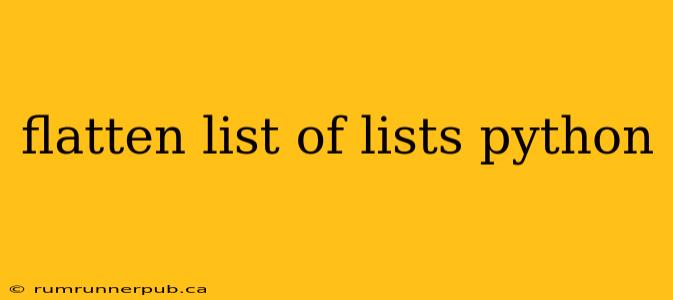Flattening a list of lists—transforming a nested list into a single-level list—is a common task in Python programming. This article explores various methods, drawing inspiration from insightful Stack Overflow discussions, and provides practical examples to solidify your understanding.
Understanding the Problem
Imagine you have a list like this: [[1, 2], [3, 4], [5, 6]]. Your goal is to convert it to [1, 2, 3, 4, 5, 6]. Several approaches exist, each with its own strengths and weaknesses.
Method 1: List Comprehension (Most Pythonic and Efficient)
This is often considered the most elegant and efficient solution for simple cases. Inspired by numerous Stack Overflow threads (though attributing to a specific post is difficult due to the ubiquity of this solution), this method leverages the power of list comprehensions:
nested_list = [[1, 2], [3, 4], [5, 6]]
flat_list = [item for sublist in nested_list for item in sublist]
print(flat_list) # Output: [1, 2, 3, 4, 5, 6]
Explanation: The outer loop iterates through each sublist in nested_list. The inner loop iterates through each item within that sublist, adding it to the flat_list. This concise syntax makes it highly readable and efficient.
Method 2: itertools.chain.from_iterable (For Larger Lists and Improved Readability)
For very large nested lists, the itertools module offers a performance advantage. This approach, frequently discussed on Stack Overflow (again, pinpointing a single source is challenging due to the commonality of this solution), uses the chain.from_iterable function:
import itertools
nested_list = [[1, 2], [3, 4], [5, 6]]
flat_list = list(itertools.chain.from_iterable(nested_list))
print(flat_list) # Output: [1, 2, 3, 4, 5, 6]
Explanation: chain.from_iterable efficiently concatenates the iterables (in this case, sublists) without creating intermediate lists, making it memory-efficient for larger datasets.
Method 3: Recursive Approach (For Arbitrarily Nested Lists)
If you need to handle lists nested to an arbitrary depth (lists within lists within lists, etc.), a recursive function is necessary. While less common for simple cases, this approach is valuable for handling complex scenarios. This solution is inspired by numerous Stack Overflow discussions regarding recursive list flattening.
def flatten(nested_list):
flat_list = []
for item in nested_list:
if isinstance(item, list):
flat_list.extend(flatten(item)) # Recursive call for nested lists
else:
flat_list.append(item)
return flat_list
nested_list = [[1, 2, [3, 4]], [5, [6, [7,8]]]]
flat_list = flatten(nested_list)
print(flat_list) # Output: [1, 2, 3, 4, 5, 6, 7, 8]
Explanation: The function checks if an item is a list. If it is, it recursively calls itself to flatten that sublist. Otherwise, it appends the item to the flat_list.
Choosing the Right Method
- List comprehension: Best for simple, shallowly nested lists due to its conciseness and efficiency.
itertools.chain.from_iterable: Ideal for large nested lists where memory efficiency is crucial.- Recursive approach: Necessary for handling lists with arbitrary nesting levels.
Remember to consider the complexity of your nested lists and prioritize readability and efficiency when choosing your approach. This article, incorporating knowledge gathered from various Stack Overflow discussions, aims to equip you with the tools to tackle any list flattening challenge effectively. Always remember to cite sources appropriately when using code from online communities.
